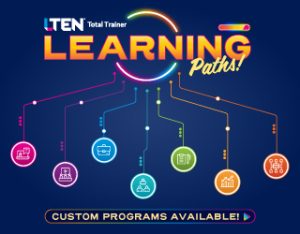
VIRTUAL TRAINING – Cindy Huggett, CPTD
What if another solution might bring better results?
It’s nearly impossible to have a conversation about virtual training without discussing the challenge of learner engagement. Remote attendees seem to be more distracted and more overwhelmed than ever before. Virtual facilitators have the difficult task of competing for their attention. And when participants aren’t engaged then they aren’t learning, and therefore won’t be able to apply new knowledge and skills on the job.
Most solutions to this challenge involve using virtual classroom tools for interactivity, like using more polls and collaborative whiteboards. Experts will tell you to add more engaging activities to help keep participant attention levels high.
That advice isn’t wrong. But what if there’s also a different answer that gets to the heart of the issue, and gives better results? What if the alternative is not to do virtual training at all?
Before jumping to conclusions about this unexpected response, consider the following three underlying reasons when virtual training might not be the best solution, and the potential actions to take instead.
Want to Learn More?
Interested in learning more from Cindy Huggett on virtual training? Join her for a special LTEN webinar, on the Zoom platform, this month.
On Aug. 22, Cindy will host the LTEN webinar Can You See Me Now? How to Effectively Use Video in Training. Click the title to register now for the free event, where Cindy will discuss when to use streaming video, provide alternatives to video and share three keys for presenting on webcams.
When the Training Topic Is Basic or Fundamental Knowledge
Not every topic belongs in a facilitated class. Many basic tasks can be learned by reading a job aid, scanning an infographic or watching an educational video.
Think about things you personally have learned without formal instruction, through self directed exploration or other methods. It’s rarely helpful to bring people together in a virtual classroom just to teach them rudimentary knowledge that they could instead learn on their own.
What to do instead? For foundational content, design relevant performance support systems like instructional guides and job aids to help those who need assistance. For more complex topics, create self-directed elearning programs that include knowledge and skill practice. If you’re concerned about completion rates, then add in compliance elements such as job-required assessments or quizzes.
When the Virtual Session Is Presentation-Style With One-Way Communication
If your training program is deliberately planned as a presentation with limited interaction, then consider carefully if it needs to be alive event with an audience. In other words, will participants benefit from passively listening to the speaker(s)? Will they pay attention, or will they be tempted to multi-task?
Presentation-style training sometimes works when a renowned expert has relevant information to share, or when it’s part of a mandated requirement (such as compliance training). But usually, remote participants disengage and multi-task in this type of setting. It’s not an ideal scenario.
What to do instead? Ask the speaker to record a video and send it to attendees. If it’s a panel, then record the conversation and make it available for offline viewing. Post it on a site that allows for comments and discussion in case questions arise, or clearly notate where a viewer can go for further assistance.
If it makes sense to have a live remote audience together for the initial recording, then do so, but use video editing tools to create and share a highlight reel of the key content. Again, if you’re concerned that participants won’t make time to watch the video, add motivating incentives to help them realize the benefits of doing so. Or include these videos as part of a blended curriculum.
When a Social Aspect Isn’t Needed
One of virtual training’s biggest advantages is its ability to bring people together simultaneously from remote locations. Virtual training is by nature a social learning experience. Participants can communicate, collaborate and learn together in a communal setting. A facilitator guides the learning activities that should lead to on-the-job application of new knowledge and skills.
But if your training program doesn’t need a community that comes together for learning, then perhaps an alternate solution would be better.
What to do instead? Consider creating a guided learning journey full of asynchronous components to achieve the learning goals. A participant could work through the material at their own pace and on their own schedule. Interactive components could come from posted discussion boards, pre-programmed chatbots or other automated exchanges.
While technology won’t fully replace social settings, if the training topic doesn’t call for collaboration, then explore individual learning applications.
Conclusion
Successful virtual training classes have an interactive design, are led by a skilled facilitator and have engaged participants. They make creative use of tools like chat, whiteboards, polling and breakout rooms.
But when this structure isn’t realistic for whatever reason, then be open to considering alternate learning options. Virtual training solves many problems but it’s not always the right solution.
 Cindy Huggett, CPTD, is a consultant and author whose books include The Facilitator’s Guide to Immersive, Blended and Hybrid Learning and Virtual Training Tools and Templates. Email her at Cindy@CindyHuggett.com or connect with her on LinkedIn at www.linkedin.com/in/cindyhuggett/.
Cindy Huggett, CPTD, is a consultant and author whose books include The Facilitator’s Guide to Immersive, Blended and Hybrid Learning and Virtual Training Tools and Templates. Email her at Cindy@CindyHuggett.com or connect with her on LinkedIn at www.linkedin.com/in/cindyhuggett/.









